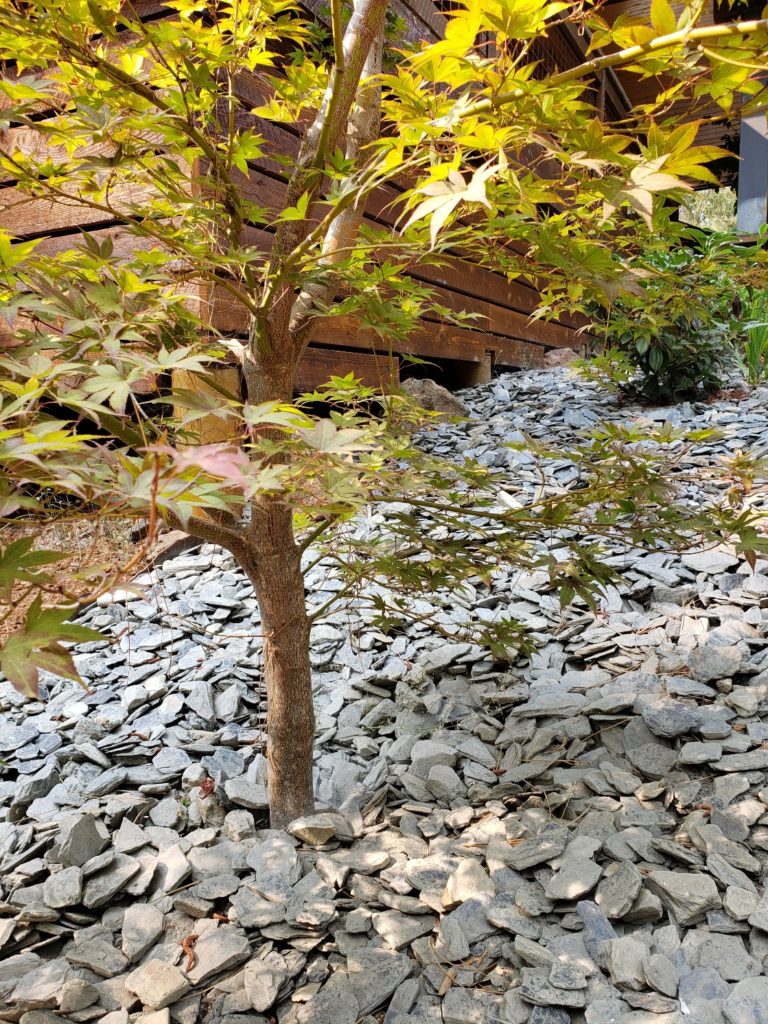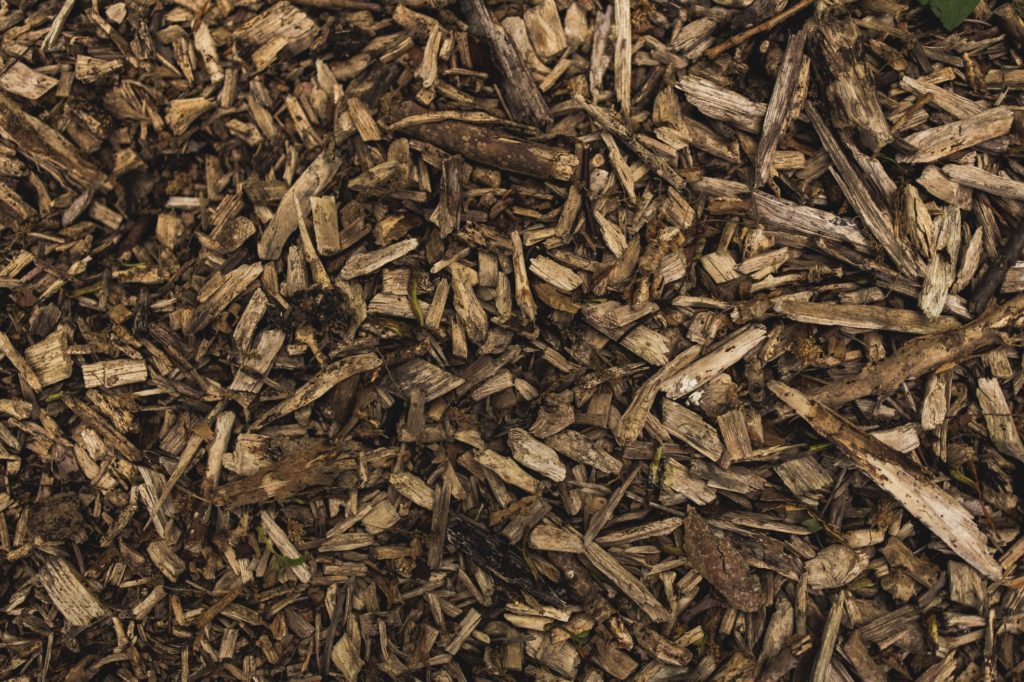Landscapes and gardens are one of the biggest users of household water, up to 30% of it. We’re all trying to keep our plants alive in the heat while reducing water use and mulching is a perfect way help. But which mulches are best, and where and how should we apply them? And what about flammability?
First, here are some of the benefits of mulching. First and foremost we mulch to reduce water use. This happens because the soil is covered so water is much less likely to evaporate out of the soil, keeping the soil moister for longer after each application of irrigation water or rain. This cuts water use by up to 25%, which is a lot.
Mulch keeps soil cooler in the hot summer and warmer in the winter. And that keeps those very important soil organisms happy and productive so they can do their work breaking down organic matter to feed your plants. Healthy soil organisms=healthy plants. And healthy plants means better drought resilience and less flammable deadwood.
Most mulches keep the soil pores open and allow water from either irrigation or rain to soak in better so the soil can hold it longer. Without mulch, soil surfaces become compacted and water runs off readily.
And mulches can do a good job at keeping the weeds at bay by blocking sunlight and smothering them.
With many mulch options, just a few are best for our wildfire-prone area
While mulch materials can range from shredded rubber recycled tires to rocks to coconuts (true!) to sawdust, let’s look at the ones most available and most useful to our Nevada County landscapes.
Anything that covers the soil to keep it from losing its moisture can be used. But the material must allow water and air into the soil, or the soil will turn anaerobic and become toxic. So plastic sheeting is not an option.
In our area, we need to look for the options that pose the least fire risk, while conserving our limited water resources.
A study to test the flammability of mulch materials was done by a group of Cooperative Extensions and Conservation Districts from California and Nevada in Carson City, Nevada. They tested 8 materials for average flame height, rate of fire spread, and maximum temp 4 “ above the mulched bed. They allowed the mulch to settle for 79 days and on a hot 100 degree, low humidity day, with an artificial wind applied to emulate extreme fire danger, they tested their mulches.
What they found is that composted wood chips, applied at 2-3 inches deep, was best by a long shot. These chips were specially composted for an 8-week period.
The close second best was what they call Tahoe chips applied in a “single layer” which gave a 80-90% soil coverage. Tahoe chips are wood chips with a variety parts of chipped tree pieces; what normally gets chipped in a utility tree trimming operation. I feel certain that this is what many of us have on or near our properties from fuel reduction efforts.
Shredded tires, pine needles, and shredded cedar fared the worst. Pine needles and shredded bark have a lot more air to volume which helps make them more flammable.
See this study in detail at this link: The Combustibility of Landscape Mulches and see also this page from the University of California Agriculture and Natural Resources.
The only bark that was trialed was pine bark, not the cedar bark that’s commonly available commercially. That wasn’t tested.
I feel that the composted wood chips would be most like wood chips we have so much of, after applied on the soil and left to be rained on through a winter or two and not disturbed. I have seen wood chips on the soil become knit together with mycelium from all the mushrooms growing naturally within the soil. They end up lying flat against the soil. The soil below them stays cool and moist much longer and the pores of the soil are open and receptive to water. And it’s obvious that the soil microorganisms and worms are flourishing, doing their work of breaking down the wood to create organic matter for soil and plant vitality.
If you have a pile of wood chips, or access to one, and you haven’t spread them yet, plan to do it once the rains have started. Let them get wet on the soil so they kind of meld with it. This, I believe will emulate composted wood chips, the lowest fire combustible mulch material tested. Place these at 2-3 inches deep. Or, go cautiously, and place wood chips any time so that they give 80-90% coverage. Then add to that cover in the winter.
A warning about using mulches
Because all of the mulches tested were flammable. The study warns that organic mulches of any kind should not be used within 5 ft. of a structure. Also keep a 10 ft. radius around gas meters and propane tanks. In these spaces use rock, gravel, decomposed gravel, concrete, or pavers.
Between 5 and 30 ft. of the house, while composted wood chips are the safest choice for mulch—which we still do need—they advise not to use it in a continuous manner. But rather, mulched areas should be separated into smaller areas and separated by rock mulch, gravel, or paved areas.

And while composted wood chips had lowest combustibility, it can slowly smolder undetected. Something to be aware of.
The best way to mulch
When applying mulch like wood chips in late fall in time for rain, be sure to keep it away from the base of plants. Not up against any trunks or stems. It’s because the mulch can rot the trunk allowing pathogens to enter the plant. Many people do this, but it’s wrong! Plants will suffer. Generally keep it 3-6 inches away from trunks and stems. Extend it out to beyond the dripline, the area at the edge of the canopy. Roots extend out farther from the base of a plant than you probably imagine.
Save the pine needles for a compost mulch
Pine needles proved to be a terrible choice for mulch in a fire-prone area. That’s not surprising, but sad because we have so much available to us. But, while it’s not good as a 3 inch mulch spread out over larger landscape plantings, it can be shredded and used as a carbon source in compost making. I make a nice coarse compost by shredding pine needles and mixing them with greens. The shredder I use is the Flowtron Leaf Eater. It shreds them right up for composting. And compost is the right sort of mulch to use on vegetable and flower beds. This goes for any other leaves, too.
Remember that organic mulches save water and build soil fertility. That means that when it does rain more of the rainfall will enter the soil. Then the mulch protects that moisture. The increased soil fertility feeds the plants for greater resilience to life’s hardships—like drought.


1 thought on “Mulch to Save Water—But What About Flammability?”
Comments are closed.